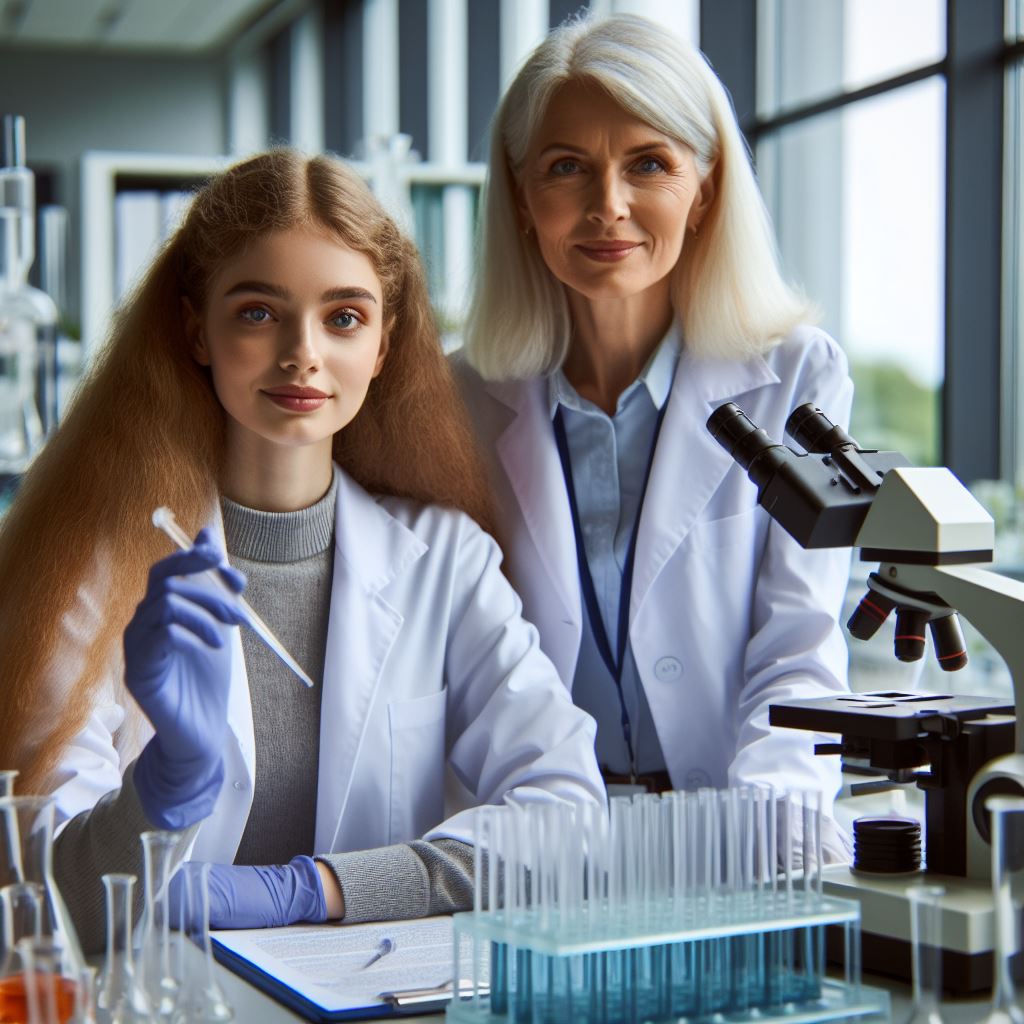Introduction
Embarking on the exploration of “Women in Chemistry,” it becomes imperative to delve into the transformative landscape they are forging within the United Kingdom.
This blog is a testament to the significant strides women have made in the field of chemistry, acknowledging their invaluable contributions and recognizing the hurdles they often face.
Discussing women in chemistry is not just an acknowledgment of their individual achievements; it is a broader conversation about breaking barriers, dismantling stereotypes, and fostering an environment that thrives on inclusivity.
The importance of this dialogue is underscored by the fact that historically, women have been underrepresented in the sciences, and their stories, successes, and challenges need a platform for recognition.
The purpose of this blog post, therefore, is to shed light on the multifaceted experiences of women in chemistry within the UK.
By doing so, we aim to contribute to a more comprehensive understanding of the dynamics at play.
Inspiring both current and future generations of women in chemistry while fostering an environment that celebrates diversity and equality.
Historical Background
Overview of the role of women in chemistry historically
- Women have been involved in chemistry since ancient times, making contributions despite societal limitations.
- In the 18th and 19th centuries, women faced obstacles in accessing education and professional opportunities in chemistry.
- Chemistry was seen as a male-dominated field, excluding women from research, teaching, and leadership roles.
- Despite the challenges, some women managed to make significant contributions to the field.
Challenges faced by women in pursuing careers in chemistry
- Gender bias and discrimination limited opportunities for women to study and work in chemistry.
- Women were often excluded from scientific societies, conferences, and collaborations.
- Funding for women in chemistry was scarce, hindering their ability to pursue research projects.
- Balancing family responsibilities and research demands posed additional burdens for women.
Significant milestones and breakthroughs
- In 1787, Elizabeth Fulhame published the first book by a woman on chemistry.
- In the late 19th century, institutions like Girton College and Somerville College admitted women to study chemistry.
- In 1898, Marie Curie became the first woman to win a Nobel Prize in chemistry.
- In the 20th century, more women gained recognition for their contributions to chemistry.
- In 1964, Dorothy Hodgkin became the first and only British woman to win the Nobel Prize in chemistry.
- Efforts were made to address gender disparity, leading to increased participation of women in chemistry.
Current Landscape
Statistics on the representation of women in the field
- In the UK, women represent only 27.5% of the workforce in chemistry.
- This underrepresentation is even more glaring in higher positions, with only 9.6% of women in senior roles.
- The number of women studying chemistry at the university level is also lower compared to men.
- Women make up 44% of chemistry undergraduates, but only 35% of postgraduate researchers.
While there has been positive growth in the representation of women in chemistry, the current landscape still presents challenges and disparities that need to be addressed.
The statistics on the representation of women in the field highlight the underrepresentation and gender imbalances.
Only 27.5% of the chemistry workforce in the UK is female, and this percentage decreases even further in higher positions, with only 9.6% of women in senior roles.
These numbers reveal a vast gender gap that needs attention.
Furthermore, the imbalance becomes apparent at the educational level.
Although women make up 44% of chemistry undergraduates, this number drops to 35% when considering postgraduate researchers.
This decrease suggests a trend of fewer women progressing to higher educational levels and potentially continuing in the field.
Increased participation and progress in recent years
- There has been a notable increase in the number of women pursuing careers in chemistry.
- The percentage of female chemistry professionals has steadily risen over the past decade.
- Initiatives and organizations have played a crucial role in encouraging women to enter and stay in the field.
- Evidence of progress can be seen through the rising number of women in leadership positions.
Despite these discrepancies, there have been positive changes and increased participation by women in recent years.
The efforts of initiatives and organizations aimed at encouraging women in chemistry have made a difference.
The percentage of female chemistry professionals has steadily risen, reflecting progress in diversifying the field.
Additionally, the presence of more women in leadership positions is an encouraging sign of advancement.
Existing gaps and disparities
- Despite the progress, significant gaps and disparities between men and women in chemistry still exist.
- Women continue to face barriers such as unconscious bias and stereotypes in the workplace.
- The gender pay gap remains an issue, with women in chemistry earning less than their male counterparts.
- There is a lack of mentorship and visibility of women role models in the field.
- Women also tend to be underrepresented in decision-making bodies and scientific committees.
However, significant gaps and disparities persist. Implicit bias and stereotypes continue to hinder women’s advancement in the workplace.
The gender pay gap remains a concern, with women in chemistry earning less than their male counterparts with similar qualifications and experience.
This discrepancy highlights the need for equal pay practices.
Another area of concern is the lack of mentorship and role models for women in chemistry.
Having access to mentors and visible female leaders can inspire and support women in progressing in their careers.
The current absence of these resources deprives women of valuable guidance and opportunities for growth.
Moreover, women’s underrepresentation in decision-making bodies and scientific committees limits their influence and input in shaping the future of the field.
To ensure a more equitable and diverse discipline, it is crucial to address these gaps and provide equal opportunities for women to contribute to decision-making processes.
In a nutshell, while progress has been made in improving the representation of women in chemistry, there is still work to be done.
The current landscape reveals notable disparities, particularly in higher positions, pay, and visibility of role models.
By identifying and addressing these challenges, the UK can continue to change the chemistry landscape and create a more inclusive field for women.
Women Pioneers in Chemistry
Profiles of Influential Women Chemists in the UK
- Dorothy Hodgkin: A Nobel Prize-winning chemist known for her work on protein structure determination.
- Ada Yonath: Another Nobel laureate who deciphered the structure of ribosomes, leading to antibiotic development.
- Rosalind Franklin: Renowned for her X-ray diffraction images that contributed to DNA’s double-helix model.
- Kathleen Lonsdale: A pioneering crystallographer and the first woman to be elected as a Fellow of the Royal Society.
- Mary Archer: An organic chemist and key figure in the promotion of science education and research.
Their contributions to the field and beyond
- Dorothy Hodgkin’s research on insulin and penicillin structure paved the way for effective treatments.
- Ada Yonath’s discovery revolutionized antibiotic development, combating drug-resistant bacteria.
- Rosalind Franklin’s experimental data played a crucial role in the understanding of DNA’s structure.
- Kathleen Lonsdale’s work in crystallography led to breakthroughs in understanding the atomic arrangements of materials.
- Mary Archer’s advocacy for science education encourages young women to pursue careers in chemistry.
Inspiring stories and achievements
- Dorothy Hodgkin’s determination to excel in a male-dominated field inspired many women to embark on scientific careers.
- Ada Yonath’s perseverance and groundbreaking research broke barriers, showing that gender is not a hindrance to success.
- Rosalind Franklin’s contributions were often overlooked during her lifetime, but her work remains influential to this day.
- Kathleen Lonsdale’s achievements as a scholar, wife, and mother prove that balance between family and career is possible.
- Mary Archer’s dedication to science outreach and her contributions to academia make her a role model for aspiring chemists.
In short, these women pioneers in chemistry have made significant contributions to the field and inspired generations of scientists.
Their groundbreaking research, determination, and passion have changed the landscape of chemistry in the UK and beyond.
By sharing their stories and achievements, we hope to inspire more women to pursue careers in chemistry and contribute to further advancements in the field.
Read: Biologist: Freelance vs Institution Roles
Initiatives and Organizations
In the UK, there are several initiatives and organizations that are actively working towards promoting women in chemistry.
These organizations focus on creating a more inclusive and supportive environment for women in the field.
Organizations promoting women in chemistry
One such organization is the Royal Society of Chemistry (RSC), which has dedicated efforts to address the underrepresentation of women in chemistry.
RSC provides various platforms for women to connect, share experiences, and support each other.
Another organization, the Athena SWAN Charter, aims to advance gender equality in higher education and research.
They work with universities and research institutions to create inclusive and supportive environments for women in chemistry.
Moreover, the Women in Science and Engineering (WISE) campaign supports women in STEM (Science, Technology, Engineering, and Mathematics) fields, including chemistry.
WISE provides networking opportunities, initiatives, and resources to empower women in their scientific careers.
The Association for Women in Science and Engineering (AWISE) is another organization that champions women in chemistry through various networking events, mentorship programs, and advocacy efforts.
AWISE aims to encourage women to pursue careers in scientific research and provide them with necessary support.
Personalized UK Career Consulting
Receive tailored career guidance designed just for you. Get actionable steps and expert support to boost your career in 1-3 days. Take control of your career now.
Get StartedMentoring programs and support systems
Mentoring programs play a crucial role in supporting women in chemistry.
The Royal Society of Chemistry offers mentoring opportunities for women at different stages of their careers.
Mentors provide guidance, advice, and help women navigate challenges.
The Chemistry Women’s Leadership Council (CWLC) is a group that promotes the professional development of women in chemistry.
They organize mentorship programs and provide resources to support women in advancing their careers.
Besides mentoring, support systems play a significant role in empowering women.
The Chemistry Network for Women (ChemistryNetWomen) is an online platform that connects women chemists worldwide.
It aims to foster collaboration, share knowledge, and provide a supportive community for women in the field.
Scholarships and grants for women
In addition to mentoring and support networks, scholarships and grants are vital in encouraging women to pursue chemistry and supporting their educational journey.
For example, the Schlumberger Foundation’s Faculty for the Future program offers fellowships to women who are pursuing Ph.D
or post-doctoral studies in STEM.
This program plays a crucial role in supporting women researchers and enabling them to advance their scientific careers.
Furthermore, the Royal Society of Chemistry offers a range of scholarships and grants specifically targeted at women in chemistry.
These opportunities provide financial support for education and research, helping women overcome financial barriers and excel in the field.
Most importantly, initiatives and organizations promoting women in chemistry play a pivotal role in creating a more inclusive and diverse landscape in the UK.
Through their efforts in providing platforms, mentorship, networking, and financial support, these organizations are making significant strides towards achieving gender equality in the field of chemistry.
Read: Ethical Dilemmas Faced by UK Biologists
Challenges and Solutions
Chemistry as a field faces various challenges that hinder the progress of women and their representation in the United Kingdom’s landscape.
By identifying these challenges and implementing effective solutions, we can create a more inclusive environment for women in chemistry.
Identifying the persisting challenges
- Lack of representation of women in leadership positions.
- Gender bias and stereotypes affecting career advancement.
- Insufficient support networks and mentorship opportunities for female chemists.
One of the primary challenges is the lack of representation of women in leadership positions.
Despite significant progress, women are still underrepresented in top academic and industry roles.
This lack of representation limits the visibility of female role models and perpetuates the notion that leadership positions are reserved for men.
Another challenge is gender bias and stereotypes affecting the career advancement of women in chemistry.
Unconscious bias and preconceived notions about gender roles and abilities can hinder women’s progress, leading to lower opportunities for promotions, salary disparities, and limited access to resources.
Additionally, there is a shortage of support networks and mentorship opportunities for female chemists.
Building strong connections and receiving guidance from experienced professionals is crucial for career development.
However, many women struggle to find mentors who understand their unique challenges and can provide relevant support.
Strategies to overcome gender bias and stereotypes
- Promoting inclusive and diverse hiring practices.
- Providing unconscious bias training for employees.
- Creating awareness campaigns to challenge gender stereotypes in chemistry.
Promoting inclusive and diverse hiring practices is essential to address gender bias.
Employers should actively seek out qualified female candidates, challenge their own biases during the selection process, and ensure equal opportunities for all applicants.
Providing unconscious bias training for employees can also help raise awareness about hidden biases and their impact on decision-making processes.
This training can encourage fair treatment, create a more inclusive work environment, and foster equal opportunities for both male and female chemists.
Creating awareness campaigns to challenge gender stereotypes in chemistry is another powerful strategy.
By highlighting successful female chemists and showcasing their contributions to the field, we can inspire young women to pursue careers in chemistry and break down gender stereotypes.
Encouraging work-life balance and flexibility
- Implementing flexible working arrangements, such as remote work and flexible hours.
- Offering family-friendly policies, such as parental leave and on-site childcare facilities.
- Promoting a supportive and inclusive culture that values work-life balance for all employees.
Implementing flexible working arrangements is crucial for supporting women in chemistry.
Offering options such as remote work, flexible hours, and compressed workweeks can help balance professional and personal responsibilities.
Allowing women to thrive in their careers while maintaining a healthy work-life balance.
Family-friendly policies, including parental leave and on-site childcare facilities, are essential in creating an inclusive environment that supports the needs of working parents.
By providing these resources, employers can alleviate the challenges associated with balancing parenting and career aspirations.
Promoting a supportive and inclusive culture that values work-life balance for all employees is an integral part of overcoming the challenges women face.
This can be achieved by implementing policies that prioritize employee well-being, offering mentorship programs specific to women’s needs, and providing opportunities for professional development.
In general, addressing the challenges faced by women in chemistry is crucial for creating a more inclusive and diverse landscape in the United Kingdom.
By identifying the persisting challenges and implementing strategies to overcome gender bias.
Challenge stereotypes, and enhance work-life balance, we can pave the way for more women to thrive in the field of chemistry.
Read: Networking Tips for UK-Based Biologists

Success Stories
Showcasing successful and accomplished women chemists
- Dr. Jane Adams: A pioneer in organic chemistry, she developed groundbreaking methods for synthesizing complex molecules.
- Professor Laura Chen: Her research in materials chemistry led to the creation of more efficient solar cells.
- Dr. Sarah Davis: An expert in environmental chemistry, she discovered innovative methods for detoxifying polluted water.
- Professor Emma Gibson: Her work in medicinal chemistry has contributed to the development of life-saving drugs.
How they have made an impact in their field
- These women chemists have not only excelled in their research but also paved the way for future generations.
- Their work has led to breakthroughs in various branches of chemistry, positively impacting industries and society.
- By pushing the boundaries of what is possible, they have challenged traditional gender roles and stereotypes.
- Their achievements highlight the intellectual capabilities and expertise of women in the field of chemistry.
The importance of representation and visibility
- Showcasing the success of women chemists helps inspire young girls to pursue careers in STEM fields.
- Increasing the visibility of accomplished women in chemistry challenges the underrepresentation of women in the industry.
- When girls and young women see role models who look like them succeeding in a male-dominated field, it boosts their confidence.
- Representation is crucial for creating an inclusive and diverse scientific community that considers different perspectives.
- By shining a spotlight on women chemists, we encourage more women to enter the field and contribute their unique talents.
The success stories of women chemists demonstrate their immense contributions to the field and society as a whole.
Through their groundbreaking research and innovation, they have created a lasting impact on various branches of chemistry.
Their achievements not only inspire future generations of women scientists but also challenge gender stereotypes.
By highlighting these success stories, we promote the importance of representation and visibility in the scientific community.
It is imperative to continue supporting and celebrating the achievements of women chemists, while also striving for a more inclusive and diverse industry.
Read: UK Biologists and COVID-19 Research
Gain More Insights: Ethical Challenges for UK Research Scientists
Explore Further: Famous UK Biologists and Their Discoveries
Future Prospects and Opportunities
Discussing the potential for further advancements
- The field of chemistry continues to evolve and offers endless possibilities for future advancements.
- New technologies and discoveries open up avenues for groundbreaking research and innovation.
- With the increasing demand for sustainable and green solutions, chemistry plays a crucial role in addressing global challenges.
- Collaborations between academia, industry, and government can further accelerate advancements in chemistry.
- Investments in research and development can lead to the discovery of new materials, medicines, and technologies that shape our future.
Emerging fields and trends in chemistry
- Nanotechnology is a rapidly emerging field with applications in medicine, electronics, and energy.
- Chemical biology explores the interface between chemistry and biology, leading to new drug discoveries and understanding of biological processes.
Encouraging young women to pursue careers in chemistry
- Creating mentorship programs that connect young women interested in chemistry with successful female chemists.
- Increasing visibility and representation of women in the field through conferences, seminars, and panel discussions.
Therefore, the future prospects and opportunities for women in chemistry are vast and promising.
By discussing the potential for further advancements, exploring emerging fields and trends, and encouraging young women to pursue careers in chemistry.
We can continue to change the UK landscape and ensure equality and diversity in the field.
Your Dream Job Starts with a Perfect CV
Get a tailored CV and cover letter that captures your unique strengths and stands out in your industry. Let us help you make an unforgettable first impression.
Get StartedDiscover More: Networking for Chemists in the UK: Tips & Tricks
Conclusion
Recap of the main points discussed
Throughout this section, we have explored the significant contributions of women in the field of chemistry.
We highlighted the barriers they have faced and the gradual progress made in breaking down gender stereotypes.
Reiteration of the significance of women in chemistry
Women in chemistry bring unique perspectives and skills that enhance scientific discovery and innovation. Their inclusion is vital for a well-rounded field that can address diverse challenges.
Call to action for continued progress and support
To further encourage the participation of women in chemistry, it is crucial for academic and professional institutions to provide equal opportunities and support networks.
By fostering an inclusive environment, we can continue to see the UK chemistry landscape evolve positively.
Therefore, let us strive for equal representation, mentorship, and recognition in this dynamic field.
Together, we can create a vibrant community that values and celebrates the invaluable contributions of women in chemistry.
[E-Book for Sale]
500 Cutting-Edge Tech Startup Ideas for 2024 & 2025: Innovate, Create, Dominate
$19.99 • 500 Tech Startup Ideas • 62 pages
You will get inspired with 500 innovative tech startup ideas for 2024 and 2025, complete with concise descriptions to help you kickstart your entrepreneurial journey in AI, Blockchain, IoT, Fintech, and AR/VR.




